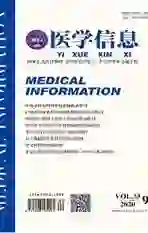慢性乙型肝炎免疫机制的研究
2020-06-08党便利康文臻孙永涛
党便利 康文臻 孙永涛
摘要:慢性乙型肝炎是一种影响全球公共卫生的传染病,由于乙型肝炎病毒(HBV)持续感染导致的常见慢性肝脏疾病。免疫应答水平决定了HBV是否继续感染,其中固有免疫仅能控制HBV的初期感染,而适应性免疫有助于清除感染病毒的细胞并提供长期免疫性保护。因此,机体免疫应答在慢性乙型肝炎的病毒清除、肝脏炎症损伤、疾病进展及治疗中发挥重要作用。本文将慢性乙型肝炎病毒感染的固有免疫和适应性免疫机制作一综述,以期为临床治疗提供参考。
关键词:慢性乙型肝炎;固有免疫;适应性免疫
中图分类号:R512.62 文献标识码:A DOI:10.3969/j.issn.1006-1959.2020.09.010
文章編号:1006-1959(2020)09-0029-03
Study on the Immune Mechanism of Chronic Hepatitis B
DANG Bian-li,KANG Wen-zhen,SUN Yong-tao
(Military Infectious Diseases Diagnosis and Treatment Center,Tangdu Hospital,Fourth Military Medical University,
Xi'an 710038,Shaanxi,China)
Abstract:Chronic hepatitis B is an infectious disease that affects global public health.It is a common chronic liver disease caused by continuous infection of hepatitis B virus (HBV). The level of immune response determines whether HBV continues to be infected. Among them, innate immunity can only control the initial infection of HBV, and adaptive immunity helps to remove cells infected with the virus and provide long-term immune protection. Therefore, the body's immune response plays an important role in the viral clearance of chronic hepatitis B, liver inflammation damage, disease progression and treatment. This article reviews the innate and adaptive immune mechanisms of chronic hepatitis B virus infection in order to provide a reference for clinical treatment.
Key words:Chronic hepatitis B;Innate immunity;Adaptive immunity
虽然乙肝疫苗已广泛使用,但全球仍有超过2.5亿人患有慢性乙型肝炎,并存在发展为肝硬化和肝癌的危险[1]。乙型肝炎病毒(hepatitis B virus,HBV)作为一种持久性病毒,在大多数情况下被认为是非细胞疾病,其发病机制是由宿主的固有免疫和适应性免疫应答介导的。尽管HBV最初可能在固有免疫防御中逃逸,T细胞对HBV感染具有细胞病变和非细胞病变双重抗病毒作用。随着慢性HBV感染,诱导各种免疫调节或耐受并产生不同程度的效应T细胞功能障碍和肝脏炎症,从而导致肝脏疾病进展[2]。本文现对慢性乙型肝炎相关的固有免疫和适应性免疫调节机制作一综述,以期为临床治疗该疾病提供参考。
1固有免疫
乙肝病毒进入后,体内的病原体激活固有免疫应答,从而阻止感染的传播并刺激适应性免疫应答。固有免疫是通过模式识别受体(pattern recognition receptors,PRRs)识别病原相关分子模式(pathogen-associated molecular patterns,PAMPs)激活,PRRs与PAMPs相互作用并活化相应免疫细胞[3,4]。病毒双链核糖核酸(double-stranded RNA,dsRNA)、单链核糖核酸(single-stranded ribonucleic acid,ssRNA)和双链脱氧核糖核酸(double-stranded DNA,dsDNA)被Toll样受体(TLR3、TLR7、TLR9)、视黄酸诱导基因-I(retinoic acid-inducible gene Ⅰ,RIG-Ⅰ)和黑色素瘤分化因子5(melanoma differentiation factor 5,MDA5)识别,从而激活核因子κB(nuclear factor kappa-B,NF-κB)和Ⅰ型干扰素(interferon,IFN)的下游产物和炎性细胞因子,促进病毒的清除[5]。干扰素尤其是IFN-α(目前用于治疗慢性乙型肝炎),通过激活JAK/STAT IFN信号通路在免疫防御中发挥主要作用[6,7]。
病毒感染初期的特征是IFN-α/β的分泌与NK细胞的活化。IFN-α/β细胞因子来源于感染的浆细胞和树突状细胞,而IFN-γ主要由自然杀伤细胞(natural killer cell,NK)和自然杀伤T(NKT)细胞产生。除了IFN-α/β外,其他细胞因子,如白细胞介素12(IL-12)和白细胞介素18(IL-18)也参与控制病毒复制感受器。NK在慢性乙型肝炎固有免疫应答过程中具有介导肝细胞凋亡、激活适应性免疫应答等功能[8-10]。另外,单核细胞和巨噬细胞也可能作为效应细胞,参与慢性乙型肝炎的固有免疫调节。慢性乙型肝炎患者肝损伤和肝纤维化的程度与CD16+单核细胞频率的上调有关,抗病毒细胞因子的分泌和凋亡细胞的清除离不开巨噬细胞[11]。
在HBV感染的黑猩猩实验中进行肝脏基因表达检测,首次发现缺乏早期固有免疫激活,导致HBV在固有免疫防御中逃逸,由IFN治疗的急性乙型肝炎患者血清水平无法升高,进一步验证了HBV逃逸现象[12,13]。这种逃逸可能发生于HBV早期感染,通过Ⅰ型IFN依赖的TLRs激活,进而抑制HBV的复制[14]。除了早期感染外,慢性乙型肝炎的爆发与血清干扰素α和IL-8水平升高有关[15]。总之,固有免疫有助于以非特异性抗原的方式控制初期感染,并没有长期的免疫记忆。
2适应性免疫
慢性乙型肝炎病毒从固有免疫应答过程中逃逸后,病毒感染的细胞将受到适应性免疫的调控。适应性免疫应答的发生源于B和T淋巴细胞系统的异质性,主要变现为B细胞、T细胞增殖过程紊乱、细胞因子产生和效应细胞毒功能紊乱以及体液免疫的部分变化。
2.1 B细胞与HBV B细胞介导适应性免疫中的体液免疫,通过产生与病毒结合的抗体,有助于抗原呈递和免疫调节,进而清除或阻断病毒进入细胞[16]。此外,通过限制病毒传播对HBV抗体做出应答,可能有助于病毒的控制和清除[17]。B细胞不仅可以产生抗体[18],也可以为T细胞呈递抗原发挥免疫调节作用,如慢性乙型肝炎中产生IL-10的调节B细胞。乙肝表面抗原(HBsAg)阴性的HBV控制者经利妥昔治疗后,CD20+B细胞耗竭的同时病毒再次被激活,因此,B細胞在HBV病毒控制中发挥关键作用。
2.2 T细胞与HBV T细胞在慢性乙型肝炎的病毒清除及疾病进展过程中发挥重要作用。随着CHB患者血清中病毒载量和HBeAg(乙型肝炎E抗原)的升高,CD3+和CD4+细胞以及CD4+/CD8+比例显著下调,但CD8+细胞数量却明显增加。CD8+T细胞可通过分泌IFN-γ和肿瘤坏死因子-α(tumor necrosis factor,TNF-α)等细胞因子或者识别主要组织相容性复合物(major histocompatibility complex,MHC)Ⅰ类分子发挥抗病毒作用[19]。CD4+T细胞经MHC Ⅱ类分子激活并分化为滤泡辅助性T细胞(follicular helper T cell,Tfh)、调节性T细胞(regulatory cells,Tregs)等不同亚型,辅助CD8+T细胞和B细胞发挥抗病毒功能[20,21],部分抗原特异性T细胞可经抗原激活[22]。HBV特异性T细胞通过高表达程序性死亡受体1(programmed cell death protein 1,PD-1)和细胞毒T淋巴细胞相关抗原4(cytotoxic T lymphocyte-associated antigen-4,CTLA-4)等共抑制分子发挥抑制效应T细胞的抗病毒应答功能,并降低靶细胞损伤等作用[23]。HBV特异性T细胞的抗病毒应答功能可由PD-1联合CD137刺激后阻断并重建[23]。Tregs和骨髓来源的抑制性细胞(myeloid-derived suppressor cells,MDSCs)的耗竭也发现类似现象。研究发现[24],在CHB患者肝脏和血液中均检测到分泌高水平IL-17的CD4+T细胞,其与血清中IL-27的高水平相关,这些细胞可能参与肝脏炎症并发挥保护功能。另外,Th17细胞的增加和Tregs的减少造成了与CHB患者疾病进展负相关的失衡。Wang S等[24]通过对miR-146a在调节CHB患者T细胞免疫反应中的潜在作用和机制进行研究,结果发现与健康对照组相比,CHB患者T细胞中miR-146a的表达明显上调,且与血清中ALT水平相关。信号转导和转录激活因子1(STAT1)作为miR-146a靶标,参与CD4+和CD8+T细胞的抗病毒细胞因子的产生及细胞毒性,并在体外阻断CHB患者T细胞中miR-146a表达,可显著上调病毒特异性T细胞的活性。T细胞分化阶段和慢性感染状态也可能存在其他抑制途径,如细胞毒T淋巴细胞相关抗原4(cytotoxic T lymphocyte-associated antigen-4,CTLA-4)、B及T淋巴细胞弱化因子(B and T lymphocyte attenuator,BTLA)和T细胞免疫球蛋白域粘蛋白域蛋白-3(T cells immunoglobulindomain and mucin domain protein-3,TIM-3),这些抑制途径的存在是为了维持肝免疫耐受[25,26]。除了抑制功能,NK细胞通过肿瘤坏死因子相关凋亡诱导配体(TNF-related apoptosis-inducing ligand,TRAIL)或BCL2家族促凋亡分子(BCL2 interacting mediator of cell death,Bim)等信号通路清除已激活HBV特异性CD8+T细胞[27-29]。此外,炎症微环境可能通过释放精氨酸酶并消耗T细胞关键营养物质(如精氨酸)或通过分泌细胞因子抑制HBV特异性T细胞的功能[30]。
3总结
慢性乙型肝炎的HBV清除、肝损伤及疾病进展均与机体免疫应答密切相关。固有免疫有助于以非特异性抗原的方式抗病毒免疫防御,并没有长期的免疫记忆。病毒最初在固有免疫过程中逃逸,提供长期免疫性保护的记忆B细胞和T细胞将清除感染病毒的细胞。虽然近年来HBV治疗取得了重大进展,在发达国家已成为一种可控的慢性疾病。然而慢性乙型肝炎还存在免疫耐受、免疫激活和感染炎症之间平衡的挑战,因此治愈仍然难以实现。靶向病毒cccDNA和抑制肝炎的同时,增强病毒特异性适应性免疫应答的联合方法可能为实现和维持慢性乙型肝炎的功能治疗提供参考。
參考文献:
[1]Liang TJ,Block TM,McMahon BJ,et al.Present and future therapies of hepatitis B:from discovery to cure[J].Hepatology,2015,62(6):1893-1908.
[2]Maini MK,Gehring AJ.The role of innate immunity in the immunopathology and treatment of HBV infection[J].J Hepatol,2016,64(1):S60-S70.
[3]Gehring AJ,Protzer U.Targeting Innate and Adaptive Immune Responses to Cure Chronic HBV Infection[J].Gastroenterology,2019,156(2):325-337.
[4]Altfeld M,Gale M Jr.Innate immunity against HIV-1 infection[J].Nat Immunol,2015,16(6):554-562.
[5]Chen X,Qian Y,Yan F,et al.5'-triphosphate-siRNA activates RIG-I-dependent type I interferon production and enhances inhibition of hepatitis B virus replication in HepG2.2.15 cells[J].Eur J Pharmacol,2013,721(1-3):86-95.
[6]Aillot L,Bonnin M,Ait-Goughoulte M,et al.Interaction between Toll-Like Receptor 9-CpG Oligodeoxynucleotides and Hepatitis B Virus Virions Leads to Entry Inhibition in Hepatocytes and Reduction of Alpha Interferon Production by Plasmacytoid Dendritic Cells[J].Antimicrob Agents Chemother,2018,62(4):e01741-17.
[7]Chen J,Xu W,Chen Y,et al.Matrix Metalloproteinase 9 Facilitates Hepatitis B Virus Replication through Binding with Type I Interferon(IFN)Receptor 1 To Repress IFN/JAK/STAT Signaling[J].J Virol,2017,91(8):e01824-16.
[8]Tjwa ET,Zoutendijk R,van Oord GW,et al.Similar frequencies,phenotype and activation status of intrahepatic NK cells in chronic HBV patients after long-term treatment with tenofovir disoproxil fumarate(TDF)[J].Antiviral Res,2016(132):70-75.
[9]Boni C,Vecchi A,Rossi M,et al.TLR7 Agonist Increases Responses of Hepatitis B Virus-Specific T Cells and Natural Killer Cells in Patients With Chronic Hepatitis B Treated With Nucleos(T)Ide Analogues[J].Gastroenterology,2018,154(6):1764-1777.
[10]Boni C,Lampertico P,Talamona L,et al.Natural killer cell phenotype modulation and natural killer/T-cell interplay in nucleos(t)ide analogue-treated hepatitis e antigen-negative patients with chronic hepatitis B[J].Hepatology,2015,62(6):1697-1709.
[11]Zhang JY,Zou ZS,Huang A,et al.Hyper-activated pro-inflammatory CD16+ monocytes correlate with the severity of liver injury and fibrosis in patients with chronic hepatitis B[J].PLoS One,2011,6(3):e17484.
[12]Wieland S,Thimme R,Purcell RH,et al.Genomic analysis of the host response to hepatitis B virus infection[J].Proc Natl Acad Sci U S A,2004,101(17):6669-6674.
[13]Dunn C,Peppa D,Khanna P,et al.Temporal analysis of early immune responses in patients with acute hepatitis B virus infection[J].Gastroenterology,2009,137(4):1289-1300.
[14]Zhang E,Lu M.Toll-like receptor (TLR)-mediated innate immune responses in the control of hepatitis B virus (HBV) infection[J].Med Microbiol Immunol,2015,204(1):11-20.
[15]Wan Z,Xie G,Wu Y,et al.Cytokines elevated in patients with HBV-related acute-on-chronic liver failure promote NK cell mediated cytotoxicity through TRAIL[J].Dig Liver Dis,2016,48(5):528-535.
[16]Liu Y,Cheng LS,Wu SD,et al.IL-10-producing regulatory B-cells suppressed effector T-cells but enhanced regulatory T-cells in chronic HBV infection[J].Clin Sci,2016,130(11):907-919. [17]Chen P,Xie Q,Lu X,et al.Serum HBeAg and HBV DNA levels are not always proportional and only high levels of HBeAg most likely correlate with high levels of HBV DNA:A community-based study[J].Medicine(Baltimore),2017,96(33):e7766.
[18]Milich DR,McLachlan A,Thornton GB,et al.Antibody production to the nucleocapsid and envelope of the hepatitis B virus primed by a single synthetic T cell site[J].Nature,1987,329(6139):547-549.
[19]Harty JT,Tvinnereim AR,White DW.CD8+ T cell effector mechanisms in resistance to infection[J].Ann Rev Immunol,2000(18):275-308.
[20]Franzese O,Kennedy PT,Gehring AJ,et al.Modulation of the CD8+-T-cell response by CD4+ CD25+ regulatory T cells in patients with hepatitis B virus infection[J].Virol,2005,79(6):3322-3328.
[21]Asabe S,Wieland SF,Chattopadhyay PK,et al.The size of the viral inoculum contributes to the outcome of Hepatitis B virus infection[J].Virol,2009,83(19):9652-9662.
[22]Park JJ,Wong DK,Wahed AS,et al.Hepatitis B Virus-Specific and Global T-Cell Dysfunction in Chronic Hepatitis B[J].Gastroenterology,2016,150(3):684-695.
[23]Bengsch B,Martin B,Thimme R.Restoration of HBV-specific CD8+ T cell function by PD-1 blockade in inactive carrier patients is linked to T cell differentiation[J].Hepatol,2014,61(6):1212-1219.
[24]Wang S,Zhang,X,Ju, Y,et al.MicroRNA-146a Feedback Suppresses T Cell Immune Function by Targeting Stat1 in Patients with Chronic Hepatitis B[J].Journal of Immunology,2013,191(1):293-301.
[25]Cai G,Nie X,Li L,et al.B and T lymphocyte attenuator is highly expressed on intrahepatic T cells during chronic HBV infection and regulates their function[J].Gastroenterol,2013,48(12):1362-1372.
[26]Knolle PA,Thimme R.Hepatic immune regulation and its involvement in viral hepatitis infection[J].Gastroenterology,2014,146(5):1193-1207.
[27]Peng H,Li QL,Hou SH,et al.Association of genetic polymorphisms in CD8+T cell inhibitory genes and susceptibility to and progression of chronic HBV infection[J].Infect Genet Evol,2015(36):467-474.
[28]Kong X,Sun R,Chen Y,et al.T Cells Drive Myeloid-Derived Suppressor Cell-Mediated CD8+T Cell Exhaustion in Hepatitis B Virus-Induced Immunotolerance[J].Immunol,2014,193(4):1645-1653.
[29]Bengsch B,Martin B,Thimme R.Restoration of HBV-specific CD8+ T cell function by PD-1 blockade in inactive carrier patients is linked to T cell differentiation[J].Hepatol,2014,61(6):1212-1219.
[30]Stoop JN,van der Molen RG,Baan CC,et al.Regulatory T cells contribute to the impaired immune response in patients with chronic hepatitis B virus infection[J].Hepatology,2005,41(4):771-777.
收稿日期:2020-03-02;修回日期:2020-03-13
編辑/杜帆
基金项目:1.“十三五”科技重大专项(编号:2017ZX10202203- 008-003,2017ZX10202101-003-007、2017ZX10202101-004-005、20 17ZX10202102-001-011);2.陕西省重点研发计划(编号:S2018- YF-YBSF-0852)
作者简介:党便利(1986.3-),女,陕西西安人,硕士,研究实习员,主要从事艾滋病免疫学发病机制的研究
通讯作者:康文臻(1966.6-),女,陕西西安人,博士,副教授,主要从事艾滋病免疫学发病机制及诊断的研究
